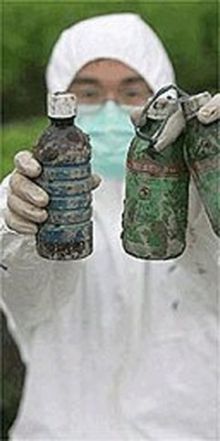
Publisher:
Bonnie King
CONTACT:
Newsroom@Salem-news.com
Advertising:
Adsales@Salem-news.com

~Truth~
~Justice~
~Peace~
TJP
Feb-21-2011 18:57

 TweetFollow @OregonNews
TweetFollow @OregonNews
Monsanto Agrees to Clean-Up of Toxic Brofiscin Quarry in Wales
Salem-News.comEnvironment Agency finds Monsanto, BP and Veolia liable for clean up after thousands of tonnes of cancer-causing chemicals.
 |
(NEWPORT, Wales GUARDIAN) - Monsanto has agreed to help clean-up a quarry in South Wales it is accused of polluting with a cocktail of toxic substances despite consistently refusing to accept liability, the Ecologist can reveal.
 John Vidal, environment editor for |
But the taxpayer could still end up meeting the estimated £2 million clean-up bill.
Waste from a Monsanto-owned plant in Newport was dumped at the Brofiscin quarry, near the village of Groesfaen, in the 1960s and 70s. Investigations since have revealed the site is heavily polluted with dangerous toxins leaking from corroding waste containers buried underground.
There are fears a major underground aquifer, which could in future supply nearby Cardiff, may be at risk of pollution from chemicals leaching from the waste. Toxins in the air and ground vapour have also recently been detected at the site.
The Environment Agency took over responsibility for cleaning up the site in 2005 but has been accused in an Ecologist investigation of failing to pursue Monsanto for its role in the pollution. In an otherwise unpublicised statement published on its website recently it now says Monsanto has been identified as one of those companies that 'should be held responsible under the contaminated land laws and be held liable for the cost of remediating Brofiscin Quarry.'
It says it is in discussions with the company to provide them with the 'opportunity to help remediate the land on a voluntary basis'. It goes on to say if the company fails to cooperate the Environment Agency will pay for the clean up costs itself - that could rise to £2 million - and attempt to recover the costs from the companies involved.
Monsanto has in the past refused to accept responsibility, saying it had contracted out waste disposal to third parties, who were told it was toxic. In a statement to the Ecologist the company still refuses to accept liability, but expressed a willingness to 'play a minor role' in cleaning up the site.
'Due to the nature of its waste hauling arrangements at the time, Monsanto UK, Ltd., is not liable for remediation of the Quarry under Wales Environmental Protection Act. Nevertheless, we are willing to play a minor role in EAW's work on the Quarry. Consultations with EAW are ongoing,' said Monsanto.
However, the Brofiscin quarry is not the only site where toxic waste from Monsanto was dumped.
Douglas Gowan is a pollution expert who represented farmers and landowners in the affected areas and originally traced back the mysterious deaths of livestock in the area to the dumping of toxic waste from Monsanto's chemical plant in nearby Newport in the 1960s and 70s. He says the Agency should now investigate pollution at least 10 other sites across the UK but fears budget constraints means it has 'no appetite to investigate and prosecute' over other locations. Monsanto itself said it not in discussions regarding clean-up costs for any other sites in the UK.
Inadequate clean-up
Gowan, who has led a long campaign against the Environment Agency's failure to hold Monsanto to account, says the Agency's current clean-up plans for Brofiscin are also inadequate and fail to deal with the contamination of groundwater supplies from the slow corrosion of the drums containing the toxins.
'When we are dealing with PCBs or doxins you are dealing with chemicals that have extremely high toxicity at tiny levels so if you do not have adequate treatment you are not going to be successful. Their solution only tackles run-off on the surface and not the real problem which is waste buried underground getting through to the acquifer. The real question is how potent is that leaking liquid? No-one knows because they have not investigated,' he said.
'I think they are just hoping it will wash away but with PCBs we just do not know what will happen. They are still there 46 years later and have not biodegraded,' said Gowan.
The Environment Agency has so far insisted that there is no 'identifiable harm or immediate danger to human health' but is keeping residents in the area updated. Speaking in the House of Lords last year, the then government deputy chief whip Lord Davies said the Agency was 'keen to reach an agreement without the need for expensive litigation'.
The other companies named by the Environment Agency are believed to have a much smaller liability. BP also dumped waste at the site while the waste company Veolia acquired the contractors originally responsible for disposing of the waste for Monsanto. Veolia were unable to comment but a spokesperson for BP said it was cooperating with the Agency.
'We are working with the Environment Agency and others on this very old site and are pleased that the remedial actions taken to date are making a positive impact. BP is looking forward to continuing to work with the EAW and others to develop remedial solutions on a voluntary basis,' said a statement.
Articles for February 20, 2011 | Articles for February 21, 2011 | Articles for February 22, 2011

googlec507860f6901db00.html
Salem-News.com:



Terms of Service | Privacy Policy
All comments and messages are approved by people and self promotional links or unacceptable comments are denied.
[Return to Top]
©2025 Salem-News.com. All opinions expressed in this article are those of the author and do not necessarily reflect those of Salem-News.com.